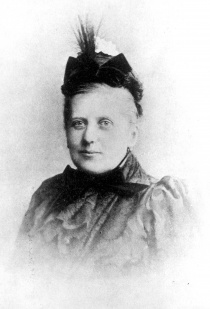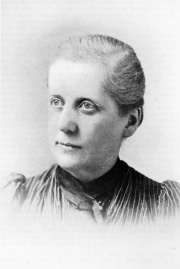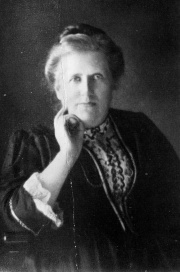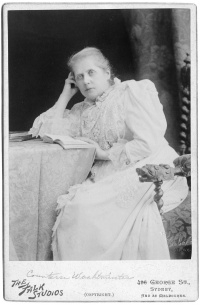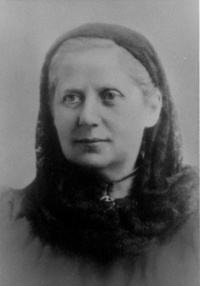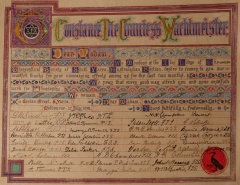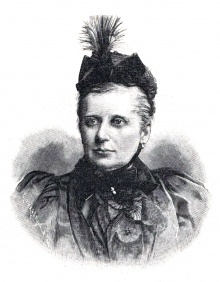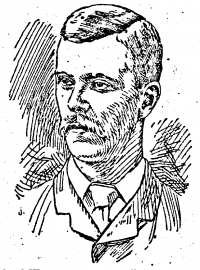Constance Wachtmeister: Difference between revisions
No edit summary |
|||
| (3 intermediate revisions by one other user not shown) | |||
| Line 11: | Line 11: | ||
She remained in Sweden for several years, spending the winter in warmer climates on account of health. Because the countess herself had some psychic abilities and had witnessed some [[phenomena]], she became interested in psychic research.<ref>Jacob Bonggren" Countess Constance Wachtmeister" ''The Theosophic Messenger'', 12.3., Dec. 1910, p. 167-168.</ref> She began investigations into [[Spiritualism]] in 1879, but after two years of arduous research she found it unsatisfactory and dangerous.<ref>Anonymous, "Faces of Friends" ''The Path'' 8.8 (Nov. 1893), 246-247.</ref> | She remained in Sweden for several years, spending the winter in warmer climates on account of health. Because the countess herself had some psychic abilities and had witnessed some [[phenomena]], she became interested in psychic research.<ref>Jacob Bonggren" Countess Constance Wachtmeister" ''The Theosophic Messenger'', 12.3., Dec. 1910, p. 167-168.</ref> She began investigations into [[Spiritualism]] in 1879, but after two years of arduous research she found it unsatisfactory and dangerous.<ref>Anonymous, "Faces of Friends" ''The Path'' 8.8 (Nov. 1893), 246-247.</ref> | ||
Eventually she found in [[Theosophy]] an explanation of the phenomena | Eventually she found in [[Theosophy]] an explanation of the phenomena <ref>Burnett and Burnett, 811-812.</ref> and joined the [[Theosophical Society]] on November 24, 1880 in Lund, Sweden.<ref>Theosophical Society General Membership Register, 1875-1942 at [http://tsmembers.org/ http://tsmembers.org/]. See book 1, entry 694 (website file: 1A/27).</ref> <ref>Anonymous, "Faces of Friends." ''The Path'' 8.8 (Nov. 1893), 246-247.</ref> All her deepest problems of life found a solution in [[Theosophy]] and from then on she devoted her whole life and fortune to the service of [[Helena Petrovna Blavatsky|Madame Blavatsky]] and her [[Mahatmas|Masters]].<ref>Burnett and Burnett, 811-812.</ref> | ||
She was a devoted Theosophist, a strict vegetarian and lived a “simple life”. <ref> C.H. van der Linden. Countess Constance Wachtmeister." | She was a devoted Theosophist, a strict vegetarian and lived a “simple life”. <ref> C.H. van der Linden. Countess Constance Wachtmeister." | ||
| Line 103: | Line 103: | ||
* '''''Practical Vegetarian Cookery'''''. San Francisco: Mercury Publishing Co.; Chicago: Theosophical Book Concern, 1897. Written with Kate Buffington Davis. Available at [https://archive.org/details/b20402405 Internet Archive], [http://wellcomelibrary.org/item/b20402405 Wellcome Library], [https://library.biblioboard.com/content/94aa357e-1304-4a7d-8d94-9f8d2b427322 Biblioboard], and others. | * '''''Practical Vegetarian Cookery'''''. San Francisco: Mercury Publishing Co.; Chicago: Theosophical Book Concern, 1897. Written with Kate Buffington Davis. Available at [https://archive.org/details/b20402405 Internet Archive], [http://wellcomelibrary.org/item/b20402405 Wellcome Library], [https://library.biblioboard.com/content/94aa357e-1304-4a7d-8d94-9f8d2b427322 Biblioboard], and others. | ||
* [https://archive.org/details/wachtmeisterspiritualisminthelightoftheosophy1897 '''''Spiritualism in the Light of Theosophy''''']. San Francisco: Mercury Publishing Co., 1897. Translated into French by Annie Besant. | * [https://archive.org/details/wachtmeisterspiritualisminthelightoftheosophy1897 '''''Spiritualism in the Light of Theosophy''''']. San Francisco: Mercury Publishing Co., 1897. Translated into French by Annie Besant. This was from a lecture at the Northwestern Spiritualists' camp meeting.<ref>"Book Reviews" ''Mercury'' 4.2 (1897), 69.</ref> | ||
* '''''Reminiscences of H. P. Blavatsky and the Secret Doctrine'''''. London: Theosophical Publishing Society; New York: The Path; Madras: Theosophical Society, 1893. Available at [https://catalog.hathitrust.org/api/volumes/oclc/4196250.html Hathitrust] and [https://archive.org/details/cu31924029173016 Internet Archive]. Translated into Spanish, Swedish, and French. | * '''''Reminiscences of H. P. Blavatsky and the Secret Doctrine'''''. London: Theosophical Publishing Society; New York: The Path; Madras: Theosophical Society, 1893. Available at [https://catalog.hathitrust.org/api/volumes/oclc/4196250.html Hathitrust] and [https://archive.org/details/cu31924029173016 Internet Archive]. Translated into Spanish, Swedish, and French. | ||
* '''''H. P. B. and The Present Crisis In The Theosophical Society'''''. [London]: Privately printed, Women's Printing Society, 1894-1895. Available at [https://theosophists.org/library/books/h-p-b-and-the-present-crisis-in-the-theosophical-society-1895/ Theosophists.org website]. Translated into Swedish, 1895. | * '''''H. P. B. and The Present Crisis In The Theosophical Society'''''. [London]: Privately printed, Women's Printing Society, 1894-1895. Available at [https://theosophists.org/library/books/h-p-b-and-the-present-crisis-in-the-theosophical-society-1895/ Theosophists.org website]. Translated into Swedish, 1895. | ||
| Line 109: | Line 109: | ||
==Axel Raoul Wachtmeister== | ==Axel Raoul Wachtmeister== | ||
[[File:Axel Wachtmeister.png|right|200px|thumb|Axel Wachtmeister, from San Francisco ''Call-Bulletin'', 1895]] | |||
Countess Constance’s only child, Alex Raoul Wachtmeister, was born on April 2nd, 1865 in London. He was a globetrotter and composed an impressive amount of music in all genres. He was only six years old when his father died and already as a young child he traveled with his mother when she was involved in Theosophical matters but also stayed with relatives and friends. He became a member of the Society on February 25, 1889.<ref>Theosophical Society General Membership Register, 1875-1942 at [http://tsmembers.org/ http://tsmembers.org/]. See book 1, entry 6793 (website file: 1C/21).</ref> After finishing his studies, he traveled the entire globe taking adventurous trips filled with hardships. He climbed the Great Pyramid of Giza, visited Kashmir and Ceylon, and socialized with writers such as Robert Louis Stevenson and Rudyard Kipling. In the company of Swedish author and Nobel Prize winner, Verner von Heidenstam, he searched for traces left behind by the soldiers of Sweden’s King Charles XII in Romania and southern Russia. In 1896 he was in Greece during the first modern Olympic Games. In | Countess Constance’s only child, Alex Raoul Wachtmeister, was born on April 2nd, 1865 in London. He was a globetrotter and composed an impressive amount of music in all genres. He was only six years old when his father died and already as a young child he traveled with his mother when she was involved in Theosophical matters but also stayed with relatives and friends. He became a member of the Society on February 25, 1889.<ref>Theosophical Society General Membership Register, 1875-1942 at [http://tsmembers.org/ http://tsmembers.org/]. See book 1, entry 6793 (website file: 1C/21).</ref> After finishing his studies, he traveled the entire globe taking adventurous trips filled with hardships. He climbed the Great Pyramid of Giza, visited Kashmir and Ceylon, and socialized with writers such as Robert Louis Stevenson and Rudyard Kipling. In the company of Swedish author and Nobel Prize winner, Verner von Heidenstam, he searched for traces left behind by the soldiers of Sweden’s King Charles XII in Romania and southern Russia. In 1896 he was in Greece during the first modern Olympic Games. In 1897 he edited the theosophical journal [[Mercury (periodical)|''Mercury'']] in San Francisco and wrote a few articles for this and other Theosophical publications.<ref>W. J. Walters, "Notices" ''Mercury'' 3.1 (June 1897), 317.</ref> He described many of his adventures and activities in his memoir written in English, ''Memories'' from 1936. | ||
Axel Raoul Wachtmeister began composing quite early and his piano piece, ''Det är qväll'' was published on his ninth birthday. He had harmony lessons, piano lessons, led a small student orchestra while working on his student examinations. After graduating he continued his studies in Copenhagen and Dresden, where he studied counterpoint and organ. Later he also studied orchestration and musical form in Paris. | Axel Raoul Wachtmeister began composing quite early and his piano piece, ''Det är qväll'' was published on his ninth birthday. He had harmony lessons, piano lessons, led a small student orchestra while working on his student examinations. After graduating he continued his studies in Copenhagen and Dresden, where he studied counterpoint and organ. Later he also studied orchestration and musical form in Paris. | ||
Latest revision as of 13:06, 18 April 2023
The Countess Wachtmeister was the companion and coworker of Helena Petrovna Blavatsky (H.P.B.) from 1885 until Blavatsky's death in 1891.[1] She lectured widely in the 1890s, and helped Annie Besant to form lodges in the United States.
Personal life
Constance Georgina Louise Bourbel de Monpincon was born in Florence, Italy on March 28, 1838, to a French father, the Marquis de Bourbel, and an English mother, Constance Bulkley.[2] Constance lost her parents at an early age and was sent to England to her aunt, Mrs. Bulkley of Linden Hall, Berkshire, where she was educated and lived until her marriage in 1863 with her cousin, the Count Wachtmeister, then Swedish and Norwegian minister at the court of St. James. They had a son, count Axel Raoul, who was born in 1865. The family moved to Stockholm, Sweden, when the Count was appointed as the Minister of Foreign Affairs. Countess Wachtmeister’s husband died in 1871. [3]
She remained in Sweden for several years, spending the winter in warmer climates on account of health. Because the countess herself had some psychic abilities and had witnessed some phenomena, she became interested in psychic research.[4] She began investigations into Spiritualism in 1879, but after two years of arduous research she found it unsatisfactory and dangerous.[5]
Eventually she found in Theosophy an explanation of the phenomena [6] and joined the Theosophical Society on November 24, 1880 in Lund, Sweden.[7] [8] All her deepest problems of life found a solution in Theosophy and from then on she devoted her whole life and fortune to the service of Madame Blavatsky and her Masters.[9]
She was a devoted Theosophist, a strict vegetarian and lived a “simple life”. [10][11]
She died on September 24, 1910 in Los Angeles.
Life with H. P. Blavatsky
After reading Blavatsky's work Isis Unveiled with wonder and admiration as well as other Theosophical books, Constance Wachtmeister joined the Theosophical Society on November 24, 1880.[12] She met Helena Petrovna Blavatsky for the first time in early 1884 in London at the home of A. P. Sinnett and his wife Patience. Soon after she received a letter from Blavatsky asking the Countess to visit her in Paris. She decided to go before returning home to Sweden and at that occasion also met the Society's Vice President, William Quan Judge. When she finally had a private conversation with H.P.B., she was told that before two years had passed, she would devote her life wholly to Theosophy, which seemed impossible to Constance Wachtmeister at that time.[13]
She happened to be in Germany when H.P.B. came there from India in 1884 and was ready to serve by entering H.P.B.’s household as an all-around helper and answering H.P.B.’s letters. She was attracted to Blavatsky's indifference to praise or blame, to her sense of duty not to be shaken by any selfish considerations. She worked faithfully for H.P.B. until her death.[14]
The countess served H.P.B. in the years when she wrote The Secret Doctrine and in Constance Wachtmeister’s own book Reminiscences of H.P.B. she writes about the remarkable phenomena she was privileged to see during the preparation of this work.[15] During these years she became a close friend of H.P.B. and stood by her in time of great distress and anxiety, both physical and social.[16]
To her is also due the credit for the successful establishment of the Theosophical Publishing Society in London. The T.S.P. had been organized to publish The Secret Doctrine and other Theosophical books and magazines. The countess had become seriously involved financially in this endeavor.[17]
Encounters with Mahatma Morya
On one or other of his early visits to Europe, Countess Wachtmeister also met Master Morya. H. P. B. mentions the fact in a letter to Mr. N. D. Khandalavala, dated July 12, 1888:
Constance Wachtmeister joined the T.S. because she recognised in the portrait of my Master her living Master who saved her on several occasions, whom she saw in his physical body years ago when he was in England, whom she saw in his astral body a number of times, and who wrote to her from the first in the same handwriting he uses for our Society. When she assured herself of this, she joined the T.S. at his advice; and now for three years and more she lives with and takes care of me."[18]
Experiences with phenomena
In the autumn of 1885 the Countess was getting ready to go to Italy to spend the winter with some friends, when a singular phenomenon happened:
I was making preparations to leave my home in Sweden to spend the winter with some friends in Italy. . . . I was arranging and laying aside the articles I intended to take with me to Italy when I heard a voice saying, "Take that book, it will be useful to you on your journey." I may as well say at once that I have the faculties of clairvoyance and clairaudience rather strongly developed. I turned my eyes on a manuscript volume I had placed among the heap of things to be locked away until my return. Certainly it seemed a singular inappropriate vade mecum for a holiday, being a collection of notes on the Tarot and passages in the Kabbalah that had been compiled for me by a friend. However, I decided to take it with me, and laid the book in the bottom of one of my traveling trunks.
On her way to Italy she stopped at Elberfeld and stayed for some days with Madame Gebhard. When she was about to depart she got a telegram from H. P. Blavatsky requesting the Countess to join her at Wurzburg. Soon after she arrived, she had the following incident:
I remember very well that it was then, on going into the dining room together to take some tea, that she said to me abruptly, as of something that had been dwelling on her mind.
"Master says you have a book for me of which I am much in need."
"No, indeed," I replied, "I have no books with me."
"Think again," she said, "Master says you were told in Sweden to bring a book on the Tarot and the Kabbalah".
Then I recollected the circumstances that I have related before. From the time I had placed the volume in the bottom of my box it had been out of my sight and out of my mind. Now, when I hurried to the bedroom, unlocked the trunk, and dived to the bottom, I found it in the same corner I had left it when packing in Sweden, undisturbed from that moment to this.[19]
Life after H.P.B.'s death
After H.P.B.’s death Countess Wachtmeister went to America and lectured in Chicago and other places, and eventually moved with her son to California to stay.[20]
Her heart and head were filled with the truth of Theosophy and she promoted the organization and teachings tirelessly. She visited every lodge of the T.S. and worked in a number of lodges to share her knowledge. Her time and energy were always at the disposal of the Cause and she helped financially whenever she could.[21][22]
Theosophical Society President-Founder Henry S. Olcott increasingly relied on Wachtmeister's judgment. When he formed a League of Theosophical Workers in 1891, he designated Wachtmeister as its first president. Late in the same year, she traveled to the Adyar headquarters, and
Olcott appointed her as president of the Women's Education league, organized to improve the education of Indian women.
Between the years 1894 and 1900 she crossed the United States from coast to coast many times lecturing, organizing, meeting people of all grades of society in her simple, matter-of-fact way. When in 1895 the American Section was left with only 14 branches, the Countess offered her services as organizer and shared her knowledge and materials at her own expense, often under tremendous difficulties, with persistence and incredible spirit.
In 1896 she organized and helped build up 12 branches, besides visiting the existing old ones. In some places, as in Chicago for example, where she gave paid lectures, she handed over the profits to the lodge. She lectured in every town where there was a possibility of listeners. She lectured also in Europe, Australia, and India, where she traveled with Annie Besant.[23] In 1897, the Countess traveled with Annie Besant across the United States for six months, with her son Axel Wachtmeister going before them as an advance agent to set up the lecture venues and dates.[24]
On the left is a certificate for Countess Wachtmeister expressing appreciation for her work at the TS of South Yarra (a lodge in a suburb of Melbourne), Australasian Section. It is dated July 1895 and signed by members of the lodge.
Writings
The Countess was an excellent writer in English and in French, and edited Theosophical Siftings. She worked with Bertram Keightley to organize the Theosophical Publishing Society. The Union Index of Theosophical Periodicals lists 446 articles by or about Constance and Axel Wachtmeister.
Pamphlet on Annie Besant as H.P.B.'s successor
At the time when American lodges split into two factions in 1895, the Countess saw it as her duty to circulate a pamphlet where she shared a few facts that she had kept to herself until then.
”H.P.B. had told the me that her successor would be a woman long before Annie Besant had become a member of the T.S. She had made various attempts with different people, hoping to find one, but was quite unsuccessful, so she became terribly depressed and downhearted saying: “There is nobody left to take my place when I am gone.” It was only when Annie Besant joined the Society that her hopes revived, for she seemed to feel that in her she would find a successor.”
The Countess continued on saying that she was at first on guard until she was sure of Annie Besant’s integrity. Only when she noticed her life of daily sacrifice and her continued endeavor to overcome her shortcomings was she convinced of her character.
“One day I saw Annie Besant enveloped in a cloud of light – Master’s color. He was standing by her side with His hand over her head. I left the room, went quickly to H.P.B. and finding her alone, told her what I had witnessed, and asked her if that was a sign that Master had chosen Annie Besant as her successor. H.P.B. replied “Yes”, and that she was glad that I had seen it. “
She further wrote that H.P.B. used to wear a ring that was important to her and had told the Countess that it would go to her successor and that the properties attached to it were magnetic. When I found out that the ring had been given to Annie Besant by H.P.B.s express directions, I knew that she would be the successor.[25]
Articles
- "The Countess Wachtmeister Defends Madame Blavatsky," The Religio-Philosophical Journal (Chicago, Illinois) May 5, 1888, p. 6. Available at Blavatsky Archives.
Books
- Practical Vegetarian Cookery. San Francisco: Mercury Publishing Co.; Chicago: Theosophical Book Concern, 1897. Written with Kate Buffington Davis. Available at Internet Archive, Wellcome Library, Biblioboard, and others.
- Spiritualism in the Light of Theosophy. San Francisco: Mercury Publishing Co., 1897. Translated into French by Annie Besant. This was from a lecture at the Northwestern Spiritualists' camp meeting.[26]
- Reminiscences of H. P. Blavatsky and the Secret Doctrine. London: Theosophical Publishing Society; New York: The Path; Madras: Theosophical Society, 1893. Available at Hathitrust and Internet Archive. Translated into Spanish, Swedish, and French.
- H. P. B. and The Present Crisis In The Theosophical Society. [London]: Privately printed, Women's Printing Society, 1894-1895. Available at Theosophists.org website. Translated into Swedish, 1895.
- Theosophy In Every-Day Life. Sydney, 1895. "Compiled by a fellow of the Theosophical Society, repr. from Theosophical Siftings, Vol. 3, by kind permission of the editor, the Countess Wachtmeister." Translated into French by Annie Besant.
Axel Raoul Wachtmeister
Countess Constance’s only child, Alex Raoul Wachtmeister, was born on April 2nd, 1865 in London. He was a globetrotter and composed an impressive amount of music in all genres. He was only six years old when his father died and already as a young child he traveled with his mother when she was involved in Theosophical matters but also stayed with relatives and friends. He became a member of the Society on February 25, 1889.[27] After finishing his studies, he traveled the entire globe taking adventurous trips filled with hardships. He climbed the Great Pyramid of Giza, visited Kashmir and Ceylon, and socialized with writers such as Robert Louis Stevenson and Rudyard Kipling. In the company of Swedish author and Nobel Prize winner, Verner von Heidenstam, he searched for traces left behind by the soldiers of Sweden’s King Charles XII in Romania and southern Russia. In 1896 he was in Greece during the first modern Olympic Games. In 1897 he edited the theosophical journal Mercury in San Francisco and wrote a few articles for this and other Theosophical publications.[28] He described many of his adventures and activities in his memoir written in English, Memories from 1936.
Axel Raoul Wachtmeister began composing quite early and his piano piece, Det är qväll was published on his ninth birthday. He had harmony lessons, piano lessons, led a small student orchestra while working on his student examinations. After graduating he continued his studies in Copenhagen and Dresden, where he studied counterpoint and organ. Later he also studied orchestration and musical form in Paris.
Axel Raoul Wachtmeister was active both as a pianist and a composer until the very end of his life. In his older years he lived for a long time in various boarding houses in Stockholm, however his last years were spent in Tyringe (Hässleholm), where he also died.[29]
The Union Index of Theosophical Periodicals lists 13 articles by Axel Wachtmeister.
Online resources
- Watchmeister, Countess Constance Georgina Louise at Theosophy World
Notes
- ↑ George E. Linton and Virginia Hanson, eds., Readers Guide to The Mahatma Letters to A. P. Sinnett (Adyar, Chennai, India: Theosophical Publishing House, 1972), 245.
- ↑ Anonymous, "Mme. Blavatsky's Companion Here: the Countess Wachtmeister Will Lecture on Theosophical Questions," New York Times (September 20, 1894).
- ↑ R.A. Burnett, Mary W. Burnett, "Death of Countess Wachtmeister." The Theosophic Messenger 12.1 (Oct. 1910), 811-812.
- ↑ Jacob Bonggren" Countess Constance Wachtmeister" The Theosophic Messenger, 12.3., Dec. 1910, p. 167-168.
- ↑ Anonymous, "Faces of Friends" The Path 8.8 (Nov. 1893), 246-247.
- ↑ Burnett and Burnett, 811-812.
- ↑ Theosophical Society General Membership Register, 1875-1942 at http://tsmembers.org/. See book 1, entry 694 (website file: 1A/27).
- ↑ Anonymous, "Faces of Friends." The Path 8.8 (Nov. 1893), 246-247.
- ↑ Burnett and Burnett, 811-812.
- ↑ C.H. van der Linden. Countess Constance Wachtmeister." The Theosophic Messenger, 12.2 (Nov. 1910), 74-76.
- ↑ Anonymous, "Faces of Friends" The Path 8.8 (Nov. 1893), 246-247.
- ↑ Theosophical Society General Membership Register, 1875-1942 at http://tsmembers.org/. See book 1, entry 694 (website file: 1A/27).
- ↑ Constance Wachtmeister, Reminiscences of H. P. Blavatsky and "The Secret Doctrine." London: Theosophical Publishing Society, 1893. Accessed at Internet Archive on 7/31/18.
- ↑ Jacob Bonggren, 167-168.
- ↑ Burnett and Burnett, 811-812.
- ↑ Anonymous, "Faces of Friends" The Path 8.8 (Nov. 1893), 246-247.
- ↑ Burnett and Burnett, 811-812.
- ↑ Mary K. Neff, The "Brothers" of Madame Blavatsky (Adyar, Madras, India: Theosophical Publishing House, 1932), 82.
- ↑ A Casebook of Encounters with the Theosophical Mahatmas Case 54, compiled and edited by Daniel H. Caldwell
- ↑ Bonggren, 167-168.
- ↑ van der Linden, 74-76.
- ↑ Anonymous, "Faces of Friends" The Path 8.8 (Nov. 1893), 246-247.
- ↑ Burnett and Burnett, 811-812.
- ↑ "A Herald of Theosophy" Boston Herald (28 August 1897), 9.
- ↑ A. K. Sibarama Shasti and Constance Wachtmeister "An Old Pamphlet of Countess Wachtmeister" The Theosophic Messenger 9.6 (Mar 1908), 120.
- ↑ "Book Reviews" Mercury 4.2 (1897), 69.
- ↑ Theosophical Society General Membership Register, 1875-1942 at http://tsmembers.org/. See book 1, entry 6793 (website file: 1C/21).
- ↑ W. J. Walters, "Notices" Mercury 3.1 (June 1897), 317.
- ↑ Axel Raoul Wachtmeister (1865−1947). Levande Musikarv, Swedish Musical Heritage. See this website.
